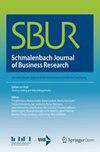寻求项目认证,创新,还是两者兼而有之?-检查高可靠性医疗保健组织中的相互依赖性
Q3 Economics, Econometrics and Finance
Schmalenbachs Zeitschrift fur Betriebswirtschaftliche Forschung
Pub Date : 2023-09-14
DOI:10.1007/s41471-023-00168-w
引用次数: 1
摘要
在动态的市场中,组织必须灵活地适应不断的变化。同时,越来越多的组织被要求采用质量管理认证。通过认证进行的标准化存在限制组织动态能力的风险。在本研究中,我们旨在评估组织寻求认证和追求创新活动的决策决定因素,认证和创新活动是否有助于组织实现其战略目标,以及认证是否影响实现二元性的能力。我们在高可靠性的医疗保健组织中探索这些关系。我们对德国提供专业癌症治疗的医院的11名医生和14名质量管理人员进行了半结构化访谈。在归纳扎根理论的方法中,我们开发了认证与创新活动之间关系的概念模型。我们发现,医院从事这两项活动,以实现质量和财务目标。对于较小的医院来说,认证是能够在市场环境中竞争的必要条件。无论竞争如何,小型医院都受益于认证对渐进式流程和产品创新的积极影响。对于较大的医院来说,获得认证是获得额外资金的必要条件,但对创新活动的影响有限,因为这些活动已经在高度密集地进行。理想情况下,项目认证和创新活动可以通过组织的双重性来实现卓越的质量和财务绩效。组织决策者必须在考虑成本和收益的同时协调这两种活动。决策者可以通过制定获得认证的激励措施来支持获得高质量的医疗服务。本文章由计算机程序翻译,如有差异,请以英文原文为准。
To Seek Program Accreditation, Innovation, or Both?—Examining the Interdependencies in High-Reliability Health Care Organizations
Abstract In dynamic markets, organizations have to be ambidextrous to adapt to constant change. Simultaneously, organizations are increasingly required to adopt quality management accreditation. Standardization through accreditation bares the risk of limiting an organization’s dynamic capabilities. In this study, we aim to evaluate the determinants of organizational decision-making to seek accreditation and pursue innovation activities, whether accreditation and innovation activities help organizations reach their strategic goals, and if accreditation affects the ability to achieve ambidexterity. We explore these relationships in high-reliability health care organizations. We conducted semi-structured interviews with 11 physicians and 14 quality managers in hospitals that provide specialized cancer care in Germany. In an inductive grounded theory approach, we develop a conceptual model of the relationship between accreditation and innovation activities. We find that hospitals engaged in both activities to achieve quality and financial goals. For smaller hospitals, accreditation was a necessary condition to be able to compete in market environments. Regardless of competition, smaller hospitals benefitted from a positive effect of accreditation on incremental process and product innovation. For larger hospitals, obtaining accreditation was a necessary condition to acquire additional funding, but the influence on innovation activities was limited because these were already being pursued with high intensity. Ideally, program accreditation and innovation activities can be aligned to achieve superior quality and financial performance through organizational ambidexterity. Organizational decision-makers must align both activities while taking account of costs and benefits. Policy makers can support access to high quality care by setting incentives to acquire accreditation.
求助全文
通过发布文献求助,成功后即可免费获取论文全文。
去求助
来源期刊

Schmalenbachs Zeitschrift fur Betriebswirtschaftliche Forschung
Economics, Econometrics and Finance-Economics, Econometrics and Finance (all)
CiteScore
2.10
自引率
0.00%
发文量
15
期刊介绍:
Schmalenbach Journal of Business Research (SBUR) is the joint official journal of Schmalenbach-Gesellschaft für Betriebswirtschaft e.V. and Verband der Hochschullehrer für Betriebswirtschaft e.V. (VHB), replacing the associations‘ former official journals Business Research (BuR), Schmalenbach Business Review (SBR), and building on Schmalenbachs Zeitschrift für betriebswirtschaftliche Forschung (ZfbF). The three journals were merged to form SBUR and ceased to publish under their previous names. SBUR publishes in the English language only.
SBUR is a fully Open Access journal. For information on the publication fees, please go to the Journal Updates section below and read the Note on the Publication Fee.
More information on SBUR and its predecessor journals, including links to their previously published content, can be found in the Journal Updates section as well.
About SBUR
Schmalenbach Journal of Business Research (SBUR) is an international English-language journal that publishes original high-quality research that is of wide interest to business research and practice. Its scope includes traditional and emerging business administration areas, including among others accounting, finance, marketing, strategic management, organization, human resource management, production and logistics management, taxation, digital business, and entrepreneurship. SBUR is open for cross-disciplinary and multi-disciplinary research. State-of-the-art review articles and thought pieces are welcome as well.
Articles apply rigorous research methodologies that fit the research questions to establish their scientific findings, such as analytical modeling, archival empirical and experimental, field and case research. To ensure high-quality scientific standards, articles submitted to SBUR are subject to a rigorous double-blind peer review, that is, reviewers are anonymous to the authors and do not see the names or affiliations of the authors.
SBUR endorses the Open Science philosophy and operates under Gold Open Access, so all published articles are freely and permanently available and accessible through this website.
 求助内容:
求助内容: 应助结果提醒方式:
应助结果提醒方式:


